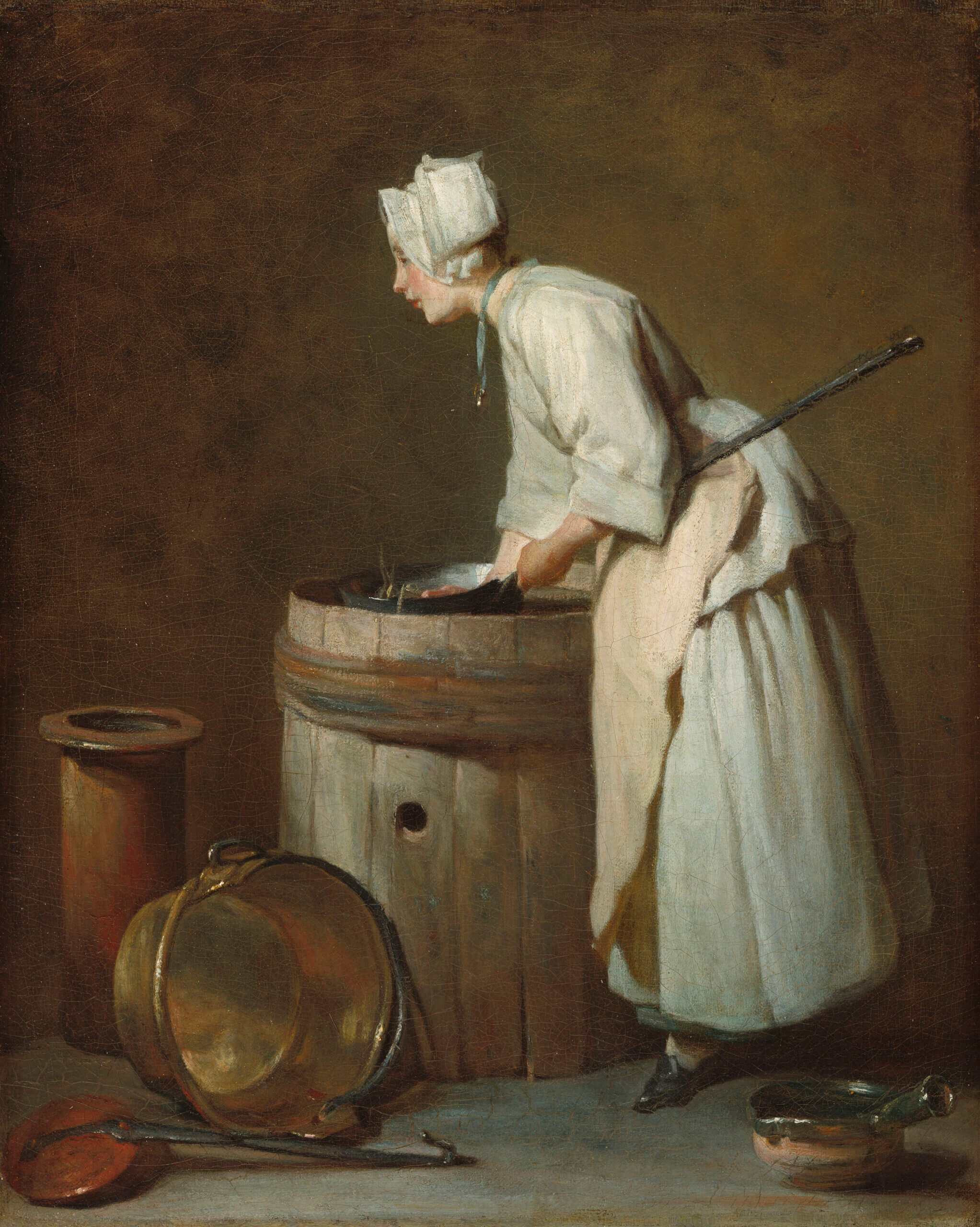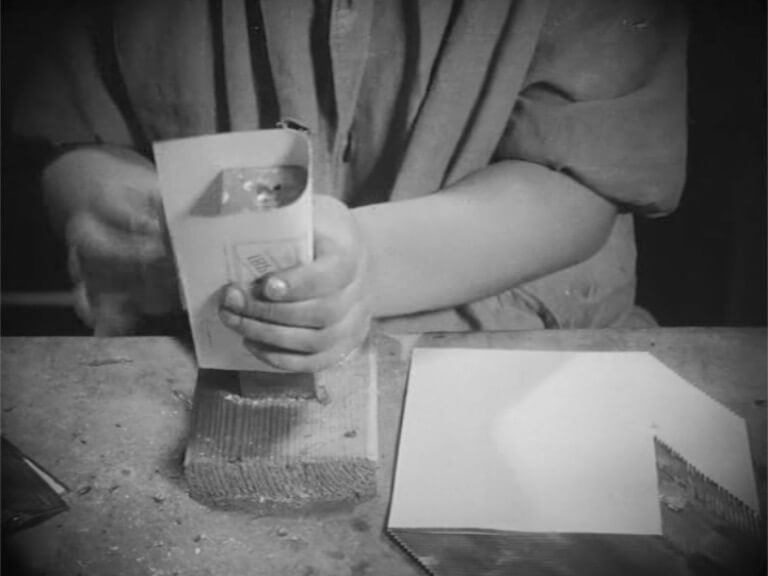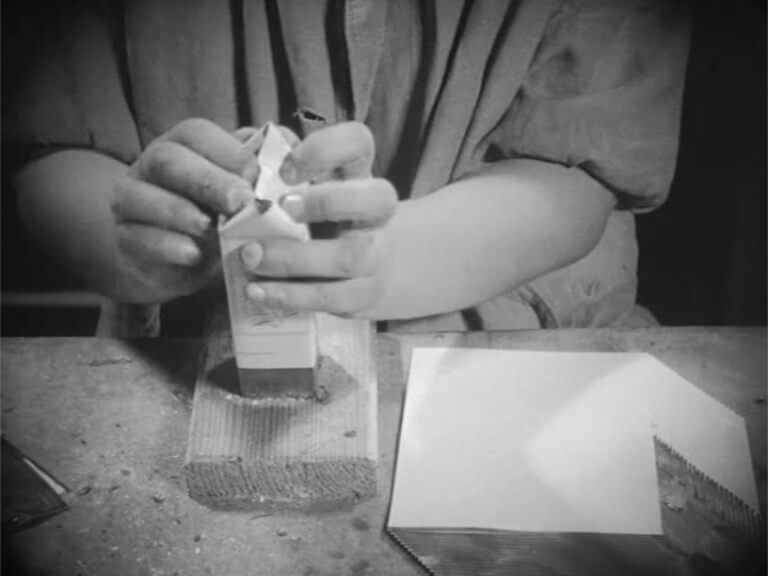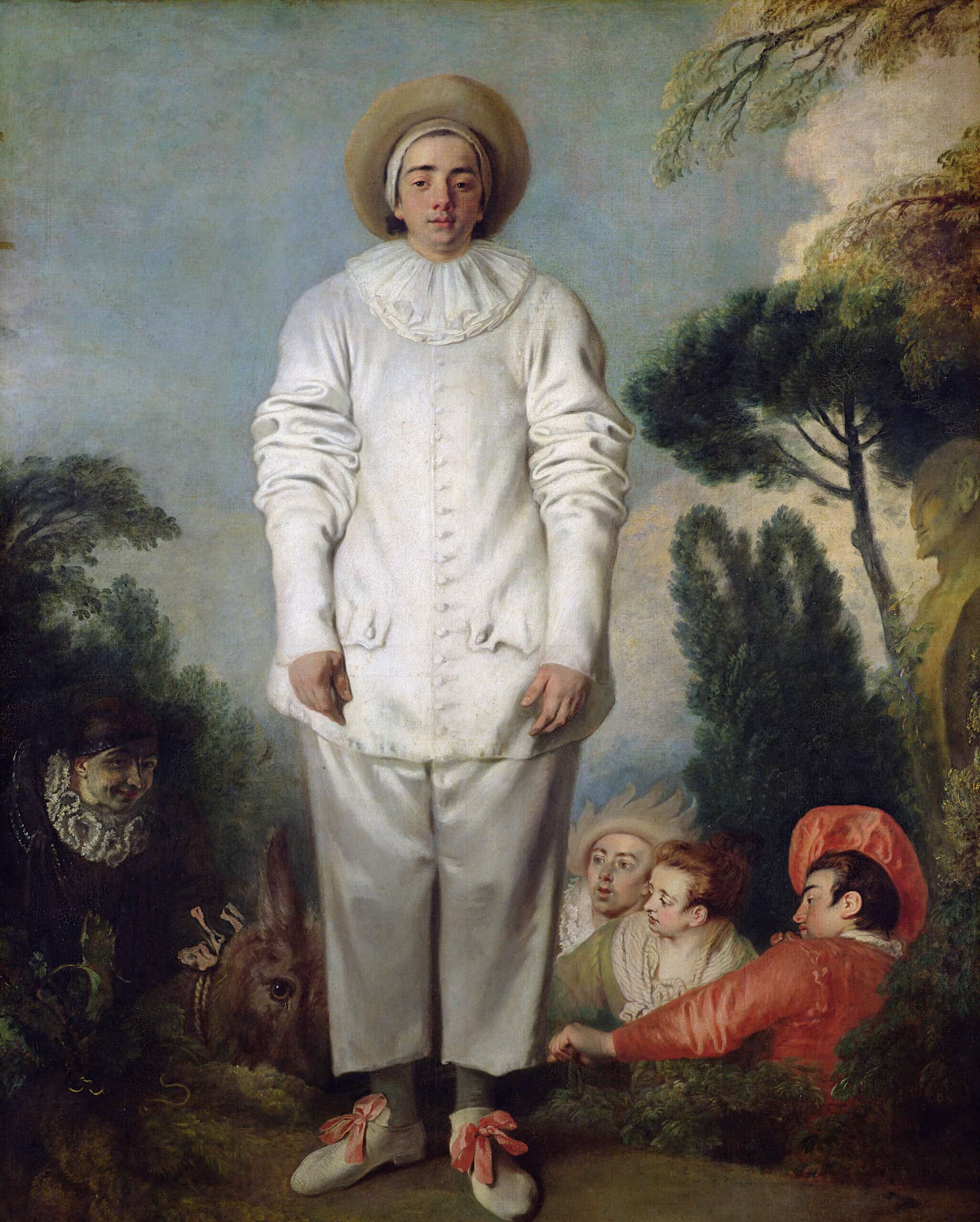At the Salon of 1739, Chardin showed The Turnip Scraper. The young woman, her rosy cheeks evoking healthy life in the fields, holds a knife for peeling turnips in her right hand. But curiously, this knife is pointing up to her left, while her left hand, crossed under the right, appears ready to let the turnip drop to her side down her white apron, holding onto it only by her fingertips. The young women’s eyes are focused neither on the vegetable nor on the instrument, but are lost in the contemplation of something the viewer can never know.
This is not the first time the painter depicted such a scene. Five years prior, he had painted a laundress whose hands are busy in the tub where the laundry is steaming, while her gaze looks off in the other direction, as absorbed by this invisible point as the small child seated next to her is by the soap bubbles. He then painted an embroiderer, whose downward gaze may at first appear intent on her work, while her dangling hand clinging to a ball of wool reveals that she has drifted off into sleep or reverie. The series is rounded out by a scullery maid and a cellar boy cleaning an earthenware jar, whose hands are busy at their task while their gaze is totally detached from what they are doing.
![Jean Siméon Chardin, <i>The Turnip Scraper</i> [also known as <i>The Kitchen Maid</i>], 1738, Washington National Gallery of Art](https://jeudepaume.org/wp-content/uploads/2021/08/la_ratisseuse_de_navet___CHARDIN.jpeg)
Taste for such domestic scenes presumably grew during this period, influenced by Flemish genre scenes. The popularity of these small-format genre paintings may have revealed the arrival on the art market of a bourgeoisie that enjoyed seeing the glorification of its domestic life, but was not in possession of sufficiently vast apartments or sufficiently refined taste to place larger format paintings of a more noble genre on its walls. This is why the painter made copies of these paintings by request. Four versions of the kitchen maid are known, not to mention the engravings.
This connection between the characters of a new type of painting and those of a rising class, however, did not take long to grow muddled. The small “bourgeois” paintings were quickly assimilated into the collections of princes with vast apartments and refined tastes. But above all, the moral and social lesson they carried was poorly grasped. These scenes were not enough to create a decor of harmonious bourgeois life as portrayed by Gérard Dou or Pieter de Hooch; and these prosaic activities were far from the joyful scenes of taverns or festivities depicted by Teniers, illustrating the health of a simple working-class condition. These workers and servants aren’t abandoning their task to go enjoy themselves: they perform it, but they do so distractedly, their gaze and thoughts turned elsewhere.
Is this absent concentration, hardly conducive to glorifying industrious bourgeois life, to be viewed as a way in which painting symbolizes itself? During the same period, Chardin painted the child with the teetotum, the boy building a house of cards, the young woman playing knucklebones and the boy blowing soap bubbles. Michael Fried has viewed their attention as symbolizing the way in which painting generates concentration on itself – the negation of the spectator, as opposed to theatre and the theatrical tradition, weighing on “great painting”. He has chosen his subjects accordingly: playing is precisely an activity that, more than any other, requires complete absorption in what you are doing. Even though the young man with the bubbles has a ripped coat and the child with the house of cards is wearing a servant’s apron, their activity is emblematic of this category of leisure which alone is able to take an activity – serious or fun – as an end in itself. They are enjoying themselves, but remain concentrated on a single task. This is exactly the opposite of what is going on with the kitchen maid, the scullery maid and the innkeeper, all of whom are clearly transgressing the Platonic commandment to do only one thing at a time. They are working with their hands, but with their head, they are thinking about something else. Or, they are simply thinking, which is not “their business”. In this regard, The Laundress is an apologue. The scene features four characters: the woman seen from behind hanging the laundry, the laundress washing the laundry but looking elsewhere, the child fascinated by bubbles, and the cat, a common symbol of domesticity and idleness – four characters who make work equivalent to its opposite, the fact of doing nothing, of being elsewhere.

Jean Siméon Chardin, The Scullery Maid, circa 1738, oil on canvas, 47 × 38.1 cm, Washington National Gallery of Art 
Jean Siméon Chardin, The Laundress, 1733, oil on canvas, 38 x 43 cm, The State Hermitage Museum
What the painter captures, and connects to the pictorial gaze – painting as a gaze – is not concentration, but the identity, at the very heart of constrained work, of attention and distraction. It is the “aesthetic” breach by which the workers’ bodies deviate from the fate imposed upon them by the dominant order – that of knowing their place and experiencing time uniformly. Because this is what defines the unbearability of a condition: not so much the materiality of work and suffering weighing on the body, as the simple fact of stolen time. This is what the carpenter Gauny would elaborate on a century later in his “descriptions” of the work day, calls to revolt against the worker’s condition. The misfortune of workers lies in the temporal prison to which the body is bound all day long, before being delivered to the night, reserved for sleeping alone – the boredom of time that is eternally the same. But this constraint can be overcome from within, transforming boredom into distraction. This is not the passive state of being elsewhere; it is the action through which time is diverted, snippets of time are freed from the eternally similar continuum, marked by tiny, decisive events differentiating the compulsory relationship between the act of working, and the subjective world. And the point of departure of this recapturing is the movement by which the gaze’s direction detaches from the hands’ work and starts to outline the new sensitive world of emancipated workers, on the very site of subjugated work.
This is the movement beginning in the absent gaze of the kitchen maid. The painter doesn’t transform a player’s concentration into painting’s concentration on itself; he transforms the distraction of a worker’s body into the deviation by which painting pulls away from the hierarchies of genres. The kitchen worker or cellar boy’s distraction is the original deviation sealing the complicity, at a distance, between workers’ bodies breaking the chains of submission and an art moving away from the social grandeurs dictating its subjects, prior to distancing itself from these “subjects” themselves.

Dziga Vertov, Man with a Movie Camera, 80 min, silent, Soviet Union, 1929 
Dziga Vertov, Man with a Movie Camera, 1929 
Dziga Vertov, Man with a Movie Camera, 1929
And yet history is more complex. Worker emancipation also produced the dream of a new world in which workers would no longer need to escape from work that had become their property. And art accompanied this dream at the time of the Russian Revolution and Taylorized work: Meyerhold’s Biomechanics and Eisenstein’s attraction montage sought to create a restless attention, common to forms of labor and forms of art. And the frenetic rhythm of work gestures in Man with a Movie Camera seems to leave no room for distraction. But, in the gesture of the joyful assembly-line worker who appears to carelessly throw cigarette packs over her shoulder while chatting with her colleagues, how is it possible not to evoke Chardin’s kitchen maid or scullery maid, and the perfect equivalence between the work of attentive hands and the distraction of the gaze?
Jacques Rancière

